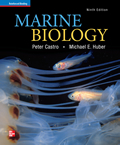1 A) Skull B) Gill or pharyngeal slits C) Dorsal nerve cord D) Tail 2 A) True B) False 3 A) Gills. B) Fins. C) Scales. D) Vertebra. 4 A) Spines B) Placoid scales C) Cycloid scales D) Dermal radula 5 A) Fish B) Seals C) Mollusks D) Plankton 6 A) Stay away from sea lion colonies. B) Don't go swimming at night. C) If you see a shark, splash at it vigorously and act aggressive. D) Don't touch a shark or grab its tail. 7 A) True B) False 8 A) Locate using the return of the pulses B) Attract plankton. C) As a courting display for mating. D) To shock the fish they eat. 9 A) They have elaborate courtship displays. B) They give birth to live young. C) They have whip-like tails and stinging spines. D) They lay egg cases. 10 A) Placoid scales B) Spines C) Ctenoid scales D) Fin rays 11 A) True B) False 12 A) True B) False 13 A) Tuna B) Trunkfish C) Manta ray D) Lionfish E) Flounder 14 A) Countershading B) A swimbladder C) Gill openings D) Dorsal and lateral fins 15 A) Accumulation of high amounts of urea to equalize total solutes to that of seawater B) Swallowing seawater C) Excreting salts by means of chloride cells D) Retaining salts in their gills 16 A) True B) False 17 A) Cryptic-coloration--blending in with rocks and coral B) Warning-coloration--bold stripes on its body and fins C) All red D) Countershaded--dark above, light below 18 A) On open sandy sea floors. B) In narrow spaces among rocks. C) Among sponges. D) near the surface of the open sea. 19 A) In the deep ocean trenches. B) In reefs and other restricted areas. C) The surface of the open-ocean. D) On the open abyssal plain areas. 20 A) vision B) the lateral line C) olfaction D) sound E) All of these 21 A) Provides hydrodynamic efficiency for swimming B) Allows colonies to form with specialized individuals, as in social insects C) Assists in regulating body heat D) Creates shadows that look like giant fish 22 A) lateral lines B) notochords C) gill rakers D) myomeres 23 Anguilla eels is essentially the opposite of that of the Pacific salmon.A) True B) False 24 A) They drift far from land. B) Most larvae remain in an egg case. C) Development takes a long time. D) The larvae may not resemble the adult form at all. 25 A) Sting rays. B) Sea horses. C) Damselfishes. D) Herring. 26 A) Oviparous B) Ovoviviparous C) Viviparous D) Hermaphroditic 27 claspers are used for internal fertilization in cartilaginous fishes.A) True B) False 28 A) Skipjack tuna B) Pacific salmon C) Herring D) Butterflyfish 29 Hermaphrodism in some fishes involves males changing into females or vice versa.A) True B) False





